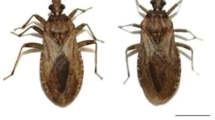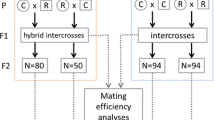Abstract
Seven known Ribautodelphax species and four recently discovered taxa were crossed. Forty-three percent of the interspecific crosses were successful. Interspecific crosses generally resulted in low numbers of hybrids. In some combinations prolonged larval development of the hybrid males was observed. Backcrosses showed that both male and female hybrids were fertile. Reproductive isolation was mainly maintained by premating barriers. Insemination tests revealed that prolonged confinement of males and females lowered mating thresholds. The taxonomic status of the known species and new taxa was shown to be in need of revision. No indications for a hybrid origin of the pseudogamous triploid Ribautodelphax females were found.
Similar content being viewed by others
References
Asche, M., Drosopoulos, S. & Hoch, H., 1986. Two new Ribautodelphax Wagner species from Greece (Homoptera Auchnorrhyncha, Fulgoromorpha Delphacidae). Marburger Ent. Publ. 2 (3): 193–210.
Barnard, C. J., 1983. Animal behaviour, ecology and evolution. Croom-Helm, 339 pp.
Booij, C. J. H., 1982a. Biosystematics of the Muellerianella complex (Homoptera, Delphacidae), hybridization studies. Genetica 57: 161–170.
Booij, C. J. H., 1982b. Biosystematics of the Muellerianella complex (Homoptera, Delphacidae) in Western Europe: patterns of variation, interrelations and speciation. Ph.D. Thesis, Wageningen. 125 pp.
Bullini, L., 1985. Speciation by hybridization in animals. Boll. Zool. 52: 121–137.
Claridge, M. F., 1985. Acoustic behavior of leafhoppers and planthoppers: species problems and speciation. In: J. R.Nault & I. G.Rodriguez (eds), The leafhoppers and planthoppers. J. Wiley & Sons, New York: 103–125.
Claridge, M. F., DenHollander, J. & Morgan, J. C., 1985. The status of weed-associated populations of the brown planthopper, Nilaparvata lugens (Stål)-Host race or biological species? Zool. J. Linn. Soc. 84: 77–90.
DenBieman, C. F. M., 1986. Acoustic differentiation and variation in planthoppers of the genus Ribautodelphax (Homoptera, Delphacidae). Neth. J. Zool. 36: 461–480.
DenBieman, C. F. M., 1987a. Host-plant relations in the planthopper genus Ribautodelphax (Homoptera, Delphacidae). Ecol. Ent. 12: 163–172.
DenBieman, C. F. M., 1987b. Variability in female calling signals in mixed populations of pseudogamous forms and bisexual Ribautodelphax species (Homoptera, Delphacidae). Neth. J. Zool. 37: 43–58.
DeVrijer, P. W. F., 1981. Reproductive isolation in the genus Javesella. Acta entomol. Fennica 38: 50–51.
Drosopoulos, S., 1976. Triploid pseudogamous biotype of the leafhopper Muellerianella fairmairei. Nature 263: 499–500.
Drosopoulos, S., 1977. Biosystematic studies on the Muellerianella complex (Delphacidae, Homoptera, Auchenorrhyncha). Meded. Landb. Hoogesch. Wageningen 77: 1–133.
Drosopoulos, S., 1978, Laboratory synthesis of a pseudogamous triploid ‘species’ of the genus, Muellerianella (Homoptera, Delphacidae). Evolution 32: 916–920.
Drosopoulos, S., 1982. Hemipterological studies in Greece, Part II. Homoptera-Auchenorrhyncha. On the family Delphacidae. Marburger ent. Publ. 1 (6): 35–88.
Funk, V. A., 1985. Phylogenetic patterns and hybridization. Ann. Missouri bot. Gard. 72: 681–715.
Gut, J., 1976. Chromosome numbers of parthenogenetic females of fifty-five species of Aphididae (Homoptera) new to cytology. Genetica 46: 279–285.
Hieber, C. S. & Cohen, J. A., 1983. Sexual selection in the lovebug, Plecia nearctica: the role of male choice. Evolution 37: 987–992.
Lokki, J. & Saura, A., 1980. Polyploidy in insect evolution. In: W. H.Lewis (ed.), Polyploidy, biological relevance. Plenum, New York: 277–312.
McMillian, W. W., 1963. Reproductive system and mating behavior of Sogata orizicola (Homoptera: Delphacidae). Ann. ent. Soc. Am. 56: 330–334.
Nast, J., 1972. Palaearctic Auchenorrhyncha (Homoptera), an annotated checklist. Polish Scientific Publishers, Warsaw, 550 pp.
Oh, R. J., 1979. Repeated copulation in the brown planthopper, Nilaparvata lugens (Stål) (Homoptera, Delphacidae). Ecol. Ent. 4: 345–353.
Rosen, D. E. 1979. Fishes from the uplands and intermontane basins of Guatemala: revisionary studies and comparative geography. Bull. Am. Mus. nat. Hist. 162: 267–367.
Ross, H. H., 1974. Biological systematics. Addison-Wesley, 345 pp.
Strübing, H. & Hasse, A., 1975. Ein Beitrag zur Neuen Systematik demonstriert am Beispiel zweier Javesella-Arten (Homoptera; Cicadina: Delphacidae). Zool. Beitr. (N.F.) 21: 517–543.
White, M. J. D., 1973. Animal cytology and evolution. Cambridge University Press, 961 pp.
White, M. J. D., 1978. Modes of speciation. W. H. Freeman and Company San Francisco, 455 pp.
Wiley, E. O., 1981. Phylogenetics. J. Wiley & Sons, New York, 439 pp.
Author information
Authors and Affiliations
Rights and permissions
About this article
Cite this article
den Bieman, C.F.M. Hybridization studies in the planthopper genus Ribautodelphax (Homoptera, Delphacidae). Genetica 76, 15–26 (1988). https://doi.org/10.1007/BF00126006
Received:
Accepted:
Issue Date:
DOI: https://doi.org/10.1007/BF00126006




